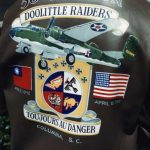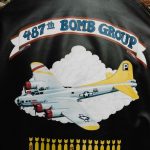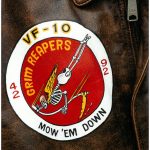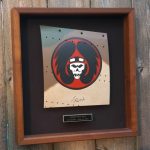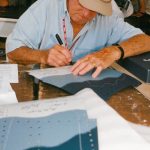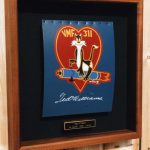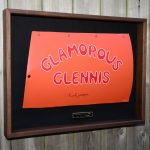For many of us with a passion for aviation, and in particular vintage military aviation, this interest also extends into aviation themed artwork. Perhaps this is because so many combat aircraft were once adorned, and occasionally still are, with “nose art” – the frequently flamboyant, not to mention lurid, hand-painted depictions and names on fuselages which gave these aircraft an almost human identity. We so often connect with these aircraft by the names their crews adorned them with – these hunks of metal, wood, plexiglas and fabric, anthropomorphized into living, breathing fellow personalities whom we often care about with deep affection. It should be no surprise, therefore, that recreated “nose art”, would be of great interest to many in our “family” of aviation enthusiasts. We learn the names of those artists whom we like…
One such artist who has made a strong impression over his many decades in the field is Ron Kaplan. His exceptional work, especially in recreating nose art designs, has also lead to some fascinating experiences with dozens of combat veteran pilots, most of whose names you will all recognize. Our very own Moreno Aguiari recently sat down with Kaplan to get a stronger idea of what drives him, and we thought you readers would be interested in reading more, as well as having a closer look at his oeuvre over the course of his career. We will begin with a recap of Kaplan’s bio, and follow with the formal interview. We hope you enjoy what you read… and see!
Ron Kaplan’s Bio
Ron Kaplan currently serves as founding director and Chairman of the Ohio Air & Space Hall of Fame and Museum (OASHOF) in Columbus, Ohio. In 2017, he left the National Aviation Hall of Fame after a 19-year contractor and staff tenure that included four as Executive Director. In 2018, he secured a state grant of $550,000 toward establishment of the OASHOF. A capital campaign to renovate the 1929 Port Columbus Air Terminal as its home is soon to commence.
A native of Columbus and 1976 graduate of Whetstone High School, Kaplan grew up with an avid interest in aviation history thanks to his father, a former B-25 pilot-instructor and licensed private pilot. He attended Ohio University for two years, studying graphic design and communications. While at O.U. he created SURF OHIO, a t-shirt line that is now a trademarked and licensed lifestyle brand.
In 1982 he founded Columbus-based Kaplan Graphics, Inc., an imprinted sportswear company that he sold in 1994 to turn his then hobby as an aviation artist, journalist and photographer into a full-time career. Kaplan went on to earn international acclaim for his illustrations of aircraft, insignia and hand-painted reproductions of vintage WWII nose-art on leather flight jackets, scrap aluminum and actual aircraft.
Among his art clients were Air & Space Magazine, the Smithsonian Air & Space Society, NIKE, Chuck Yeager, Inc., the Miss America P-51 Air Racing Team, the Memphis Belle Memorial Association, and many other individuals including WWII veteran aviators and warbird owner/operators. Kaplan was an artist member of the American Society of Aviation Artists, the U.S. Air Force Art Program, and a charter member of the International Society of Aviation Photographers. He has been a contributing editor to FLIGHT JOURNAL and columnist for WARBIRD DIGEST magazines.
Kaplan moved to Dayton in 1995 and joined the staff of the Congressionally chartered, non-profit 501(c)(3) National Aviation Hall of Fame (NAHF) as Development Director in 1998. He later served as the Hall of Fame’s Marketing and Deputy Director before being promoted to Executive Director in 2005, serving that role until 2009. In addition to fundraising and sponsorship, Kaplan’s responsibilities included overseeing operation and development of the NAHF Learning & Research Center and its exhibits, implementing NAHF public education and outreach programs, editing the quarterly membership magazine, founding and directing the Reel Stuff Film Festival of Aviation, and producing the organization’s annual enshrinement ceremony, widely known as “America’s Oscar Night of Aviation.”
He is also a co-founder and co-director of the annual National Aviation Heritage Invitational (NAHI), created in 1999 in partnership with the Reno Air Racing Association and the Smithsonian Air & Space Museum. NAHI is a preeminent competition for the restoration of vintage aircraft to flying condition.
After leaving the staff of the NAHF in late 2009, Kaplan became a contractor to the organization, holding the title of Director of Enshrinement & Outreach until his resignation in 2017. In 2012 he launched Reel Stuff Aviation Resources LLC, a consultancy dedicated to the development, creation and public appreciation of aviation cinema and broadcast projects. Reel Stuff also provides marketing, production, branding and public relations services, with a client list that includes the Air Force Museum Foundation, Aviation Community Foundation, Bremont Watch Company, Army Aviation Association of America, Tockr Watch Company and the Columbus Center of Science of Industry, among others.
Kaplan resides in Kettering, Ohio, with his wife, Jennifer, and their two boys, Maxwell (age 18) and Mitchell (age 16). His grown twin sons, Zachary and Alexander, and four grandchildren reside in his hometown of Columbus.
The Interview
- Where did it all start for you? Where does your love for aviation come from?
Somehow I became an aviation buff from birth! My Dad, Robert, had been a B-25 pilot-instructor in WWII, and later a licensed private pilot. AOPA Pilot and Air Progress were two of the first magazines I ever became aware of. So that of course was an influence, but with the mystery being why my two older and one younger brother didn’t also get bit. My mom and dad were hugely supportive of my passion for aviation, and also my creative interests. They saw no harm in my blowing every cent of my allowance on plastic model kits or Ballantine paperbacks. I still have many of the aviation books they gave me as presents. Notable among them is Eddie Rickenbacker’s autobiography, a personalized, signed copy my dad gave me when I was 10 or 11. My dad had met him at a book signing. I was so enthralled with Capt. Eddie that I wrote him – twice – and he wrote back both times. I still have the letters – they’re family heirlooms! So I can say that my dad and Captain Eddie are my first two aviation heroes. Sadly my dad passed away on New Years Day 2016. But he is never forgotten.
- What about your artistic skills, is this something you always had or your passion for WWII art helped develop them?
If I got the aviation genes from my dad, I certainly got the art genes from my mom, Beverly. She could paint and draw, and her sister was a professional artist. There were other artists and musicians in the family. I missed out on the music genes – my little brother got those – but I cannot recall a time in my youth that I was not sketching or painting. It was like breathing. Again, I was blessed to have hugely supportive parents. Now, as a dad of four, I can see the sacrifices they made to send me to special art programs on weekends at places like Columbus College of Art and Design, and Ohio State. The Ohio State course was in multi-media storytelling, and for my subject I picked the Battle of Britain, just so I could use images of Spitfires! I took summer school art classes every summer through grade school, happily, until they interfered with football conditioning in high school. But by that time I had met all my art requirements for graduation and could pretty much create what I wanted during free time in the art room. Something that many find of interest is that I am quite colorblind, but that aspect of my career would take up pages to explain. I’ve kept a watercolor of a Me 109 I did in junior high because the airplane looks pretty good, but the Mediterranean Sea in the background is purple. Seriously. Because the watercolors in the tray are not labeled. I should mention that, by high school, my artwork still included airplanes but just as often had hotrods, surfing and girls as the subjects!
- What was your first piece and what subject? Why?
What I would count as my first real painting was the result of having a great summer school art teacher, Mr. McClin, in 1973 between 9th and 10th grade. It was the first large, full color canvas project I was ever forced to paint, something like 30” by 36’, which is daunting to a kid that had typically worked in sketch books and on some small canvas boards. A great air-to-air photo in one my dad’s copies of Flying Magazine of a Pitts Special doing acrobatics had caught my eye. I worked it into a nice composition that almost made it look abstract even though it was realism. I will never forget how the final result really lit me up, at that young age, and got me pointed into using acrylics and doing larger than my usual paintings with confidence. It also enlightened me more about the merits of good design – use of shapes, lines, color, movement and all. That piece hung prominently my parents’ condo for some 20 years, rattled around the family, and now I have it back. Can’t get rid of it!
- How do you choose your subjects?
I’ve never had any problem with finding interesting subjects. It was around 1990 when I started getting burned out on running my graphics company in Columbus, and decided to get back into aviation art. I couldn’t resist the combination of leather flight jackets with painted nose-art on the back. I had a copy of the wonderful nose-art book Classy Chassy, since college, so I turned to that for some inspiration. Nothing wrong with replicating Petty and Vargas nose-art! But then the Gulf War happened, and after painting a jacket with a Warthog from the 23rd TFW on it, the warbird commissions that resulted directed me further into aircraft illustration. Painting the jacket of a BT-13 owner I flew with stirred up some key commissions from patrons owning warbirds. And gifting a jacket I painted to the Doolittle Raiders at their 50th anniversary in 1992 also drew me further into both insignia and aircraft illustration. My dad and I made it a road trip to Columbia, South Carolina, for that presentation, by the way. A treasured memory. And it lead to later artworks that were signed by various Raiders.
The interest in insignia came hand in hand, especially with my background in graphic and logo design. I just love the American folk art aspect of both the nose-art and aviation unit insignia. To me, they are like a bottomless pit of inspiration, especially knowing I am keeping the memory of veterans alive in the process of my art. Each insignia has a colorful heritage attached. As for aircraft, I can’t say I have a single favorite subject to paint. I’ve painted everything from Waco gliders to many P-51 Mustangs to a Gulfstream V on A-2s. Each one was a blast, though I got out of the jacket painting business years ago and now stick with aircraft aluminum and good old canvas.
The painted aluminum first started with the idea I would replicate nose-art cut as if cut from a B-17 or Spitfire or such. At around 3’ by 4’ on average, they were fun to research and create, and sold well enough, but I heard so many people say that they were just too large for their home. When I shifted thought to doing smaller pieces around 1995, I realized a couple of key things – one, they would look good in a shadow box frame with an engraved I.D. plaque, and two, I could carry or ship such smaller pieces around easily and thus additionally have pilots autograph the panels that would feature their own squadron insignia or nose-art. At that time I was working with Paul Tibbets, assisting at Charles Osborn’s warbird show near Louisville, and also helping at the Gathering of Eagles at Maxwell Air Force Base. I refined the concept to creating very limited editions of aircraft scrap that each would be signed, adding value. So the subjects – the aces and pilots – of each edition really dictated the art that was to adorn their edition. Over the years, I was able to create over 100 such signed editions, most averaging just 10 or 12 pieces per aviator’s edition to keep them really rare. In lieu of a certificate-of-authenticity, I provide a photo that was taken at the signing session. My “inventory list” is a pretty impressive who’s who of military aviation, especially heavy with WWII aces. But there are some other unique editions, too, like the Ted Williams/VMF-311 on actual scrap F9F Panther skin, and American fighter pilot Rudy Augarten, who became an ace while flying as a volunteer for Israel in 1948. His edition is on actual Bf 109G skin, similar the Czech-built S-199’s he flew in 101 Squadron. The fun is in never knowing what a patron might order next. Everyone has their favorite ace, air battle, or branch of service. Or maybe it’s a pilot they once got to meet or flew with at an airshow. I have some longtime patrons that have a collection of my panels and seem to add another every so often. And there are other collectors that are mainly interested in the one-of-a-kind signed aluminum pieces I’ve done along the way, especially those on aluminum of the actual type flown by the pilot or pilots that signed it.
I’ve occasionally given thought to additional ways to sell my art beyond the original paintings on autographed metal, themselves, something that work at scale. Isaiah Jones, owner of MTS Toys and Hobbies in Beavercreek, Ohio, has long offered my aluminum panel editions in the shop, and provides valuable customer feedback. When he suggested last fall that I think about creating canvas giclée reproductions of my aviation art, for a lower price-point series, I started painting insignia on 12” square canvasses I had laying around my studio, in the same painting style I use on the aluminum. After getting them professionally photographed at high resolution for the giclée process, I had another thought. My two oldest boys, twins, each own their own business in Columbus. Zach has an apparel and printing company, and Alex owns a shop that up-cycles a lot of wood into cool products, décor and awards. One day Alex had hundreds of wood coasters in production for Zach’s operation to print for a corporate client. After showing them the scans of my recent canvas work, we figured out that Alex could make 4” by 4” coasters out of sliced vintage barn beams, and Zach could laser print my insignia onto them. The process of sealing them in spar adds to their vintage appearance. Thus my latest product line is “Famous Fighter Squadrons of the 8th Air Force” and “Famous Troop Carrier Squadrons of D-Day,” each being a set of four coasters adorned with my insignia replications. I debuted them at the MTS tent in the AirVenture Fly Market, and am pleased that my first two retail customers are Sporty’s gift catalogs and the gift shop at the Air Force Museum. Ideally I will add more museum gift shops soon. I’m resurrecting my dormant website, www.warbirdaviationart.com, for the panel editions but now also for online orders that will include subsequent coaster sets, with Famous Marine Corps Corsair Squadrons and Famous B-17 Squadrons of the 8th Air Force now in the works. And having sold four of the original 12” square canvas paintings used for the first coaster sets, I plan to finally get back on track the creation of those canvas giclees, the idea that started this all!
- Please explain the research process behind each subject.
That can differ widely, depending on the project or commission. For my insignia work, I keep a digital file folder of any that 1) capture my fancy visually, and 2) I know are historically significant. It’s a big folder and I add to it frequently, especially with period photos that are like discovering gold to me. The same is done with hardcopy folders that are my key resources when it comes to paint. I have a rather extensive library of reference books, but as we know, the web expands the ability to track things down. And as far as authentic Air Corps and Air Force emblems go, the folks at the Air Force Historical Research Agency are often a huge help. There are some fellow aviation artists out there who also generously share their reference material, and I try to reciprocate when I can. The more artists keeping this history alive, the better.
With the autographed aluminum series I started in the mid-1990s, the subject is as mentioned driven by which unit insignia the signing pilot had at the particular time represented by the edition. For instance, the Robin Olds edition featuring the 434th Fighter Squadron edition representing his service flying P-38s is a different emblem from that when flying Mustangs in the 434th. And I was fortunate to have him connect me with his crew chief to get the correct artwork for both. With the first of two editions I did with Marine Corps ace and Medal of Honor recipient, Jim Swett, I opted to use the cartoon tail-art that adorned his Wildcat at one time. There was only one known color photo taken of it. He kindly sent me an 8×10 copy to work from, even though I had stupidly said, “I’m surprise you don’t have more photos of your Wildcat.” Reminding me they were flying off of Guadalcanal, he said, “Son, we were a little too busy to take pictures.” Duh.
With a commissioned piece, the patron has something specific already in mind, typically along with some good reference sources to share with me. I recently completed a couple of commissions on fabric, one a 22nd Aero Squadron (WWI SPAD) piece and another replicating an early Wright Field insignia that I had to give a weathered and antiqued look. Frankly I find doing the networking and detective work of researching pieces like that half of the fun.
- What is your favorite piece/subject and why?
Wow, picking a favorite piece or subject is tough. I get engrossed in whatever is on my studio table and on-deck to be next. It’s much easier to mention projects that were fun, significant and rewarding at a remarkable scale. Certainly working with Paul Tibbets was a treat, and it started when I created the artwork for the Atomic Bomb protest stamp in 1995 for the Vietnam veteran who came up with the idea. Of course the ENOLA GAY panel editions are significant, but I also did a series that features the RED GREMLIN nose-art from the B-17 Tibbets flew in the earliest days of the 8th Air Force. He got a kick out of that, which warmed my heart. Speaking of B-17 nose-art, I have a long, colorful history with the MEMPHIS BELLE and its pilot Bob Morgan, including working with the Memphis Belle Memorial Association when the plane was still on Mud Island, and also, thanks to Bob’s recommendation, painting the nose-art on David Tallichet’s movie MEMPHIS BELLE in 1999 after the movie paint job wore off. In fact, I have likely painted the BELLE nose art more times, and at more sizes (including for stamp art), than any artist I know!
I also was rewarded in multiple ways by painting limited edition jackets for the Miss America P-51 Air Racing Team back in 1996, for owner Doc Heisey, when my jacket design was adopted as the team’s official logo. Given one of this kid’s earliest Cox U-control models was a Miss America Mustang, being “on the team” and eventually meeting Howie Keefe, in person, was pretty dang cool. And that’s the project that began my involvement with Reno, now going on for almost 25 years now.
- Please share cool anecdotes about meeting the WWII legends. I am sure you must have some!
I’ve often lamented not having a video camera strapped to my head while working with these incredible heroes. I am blessed to have had dozens upon dozens of remarkable moments. Though I am not so sure it warrants a book, as many friends have suggested, I have been having fun recently giving presentations about my warbird art and sharing some favorite stories and photos. My experiences with these aviation heroes was not limited to just doing signed editions and art projects. I also enjoyed helping various organizations and events that hosted them.
In 1996, for instance, I volunteered as a van driver and “aide de camp” for the Wings of Valor Tour/History Symposium, produced by retired Air Force Lt. Col. David McFarland, famous for establishing the Gathering of Eagles at Maxwell AFB each year. The Valor tour featured William Lawley (AAF), Gunther Rall (Luftwaffe), William “Bill” Reed (RAF), and Vitali Popkov (USSR). Each had received their nation’s highest honor for valor in combat. They were making appearances at museums in the southeast and up to the Smithsonian in D.C. We happened to be at MacDill AFB in Florida while Sun-N-Fun was going on, so we took everyone there for a day of watching the warbirds fly. I had escort duty for General Rall for the tour, resulting in many priceless memories. He was fun, younger than his years, though always the General, in my eyes. When the P-51 Mustangs were ready to take off for their flyovers, and there were at least a dozen, the General wanted to be right by the taxiway to see them off. Given his VIP status, no problem. It was funny to see the old General was just like me, an over-caffeinated kid in a candy store, to be so close you could almost touch the wingtip of each Mustang as it chugged by us. He was hopping and bopping around, grinning with excitement. After about the ninth or tenth Mustang passed by, I leaned in and, over the din of Merlins, shouted, “This is AMAZING, isn’t it?!” Without even a pause, General Rall shouted back, “JA, JA!! VEE OBVIOUSLY DID NOT SHOOT ENOUGH OF ZEMM DOWN!”
After touring Embry-Riddle University, we also took them to lunch at the Hooter’s in Daytona Beach. But that’s a tale better left for another time!
I had the pleasure of spending many occasions over the years with Flying Tiger ace, ‘Tex’ Hill, including when I assisted with the Aviation Nation air shows at Nellis AFB in Las Vegas. I typically had a number of “celebrity” pilots to care for at Aviation Nation, and layering on media chores and transportation planning really had me on my toes. ‘Tex’ was a beloved character among characters. One night, after I finally had things settled down, I went to the pub in our hotel to rejoin Tex and some others for what would be a late night-cap. As I walked through the doors I hear ‘Tex’ shout, “Get a drink, Kaplan!”, followed by, “You get all them squirrels up that tree yet?” Man, I bet I have used that saying a hundred times since then. And I indeed am still trying to get all them squirrels up the tree!
But at the end of the day, the best memories for me are of having my four boys get to meet and know many of these great heroes. They can bore their grandkids one day with tales of having met the likes of Joe Foss, Bud Anderson, Charles McGee, Bob Hoover – the list goes on and they have the family photo albums to prove it. Because keeping their memory of our heroes and legends alive, and teaching others about their incredible contributions to aviation are what it’s all about. I consider it a mission to do what I can, be it through writing, speaking, photography or artwork. It’s a total blast for a born aviation nut like me.










